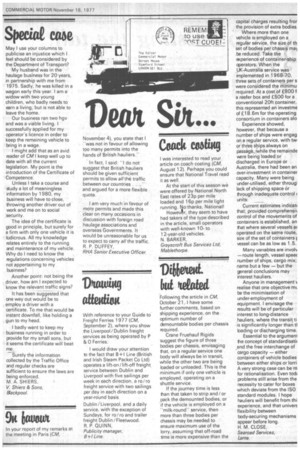Diiktegt.
Page 45

If you've noticed an error in this article please click here to report it so we can fix it.
but tefatal
Following the article in CM, October 21, I have some further comments, based on shipping experience, on the optimum number of demountable bodies per chassis required.
Crane Fruehauf Rigids suggest the figure of three bodies per chassis, envisaging that, on a regular service one body will always be in transit, while the other two are being loaded or unloaded. This is the minimum if only one vehicle is employed, operating on a shuttle service.
If the journey time is less than that taken to strip and/or .pack the demounted bodies, or if the vehicle is employed on a "milk-roundservice, then more than three bodies per chassis may be.needed to ensure maximum use of the lorry, assuming that off-road time is more expensive than the
capital charges resulting fror the provision of extra bodies Where more than one vehicle is employed on a regular service, the size of th set of bodies per chassis ma) be reduced. Take the Experience of container-ship operators. When the UK-Australia service was implemented in 1968-70, three sets of containers per s were considered the minimu required. At a cost of £800 f a reefer box and C500 for a conventional 20ft container, this represented an investme of £18.6m for the operating consortium in containers alo Experience showed, however, that because a number of ships were engag on a regular service, with twi or three ships always on passage, while the remainde ■ Aere being loaded or discharged in Europe or Australia, there had been an over-investment in container capacity. Many were being under-utilised, either througl lack of shipping space Or through inadequate control units-.
Current estimates indicati that, provided conaprehensiv control of the movements of containers is established, an that where several vessels ar operated on the same route, size of the set of containers r vessel can be as low as 1.5.
Many variables are involv — route length, vessel speec number of ships, cargo mix, name but a few — but the general conclusions may interest hauliers.
Anyone in management v realise that one objective mi be the minimisation of under-employment of equipment. I envisage the results will be of particular interest to long-distance ,hauliers, where the transit ti is significantly longer than tl loading or discharging time.
Essential to the argument the concept of standardisati( and the free interchange of cargo capacity — either containers of vehicle bodies between either ships or lorri Avery strong case can be m for rationalisation. Even todi problems still arise from the necessity to cater for boxes which deviate from the ISO standard modules. I hope hauliers will benefit from thi experience, and that univer5 flexibility between body-securing mechanisms appear before long.
H. M. CLOSE, Searoad Services, Lame.








































































































































